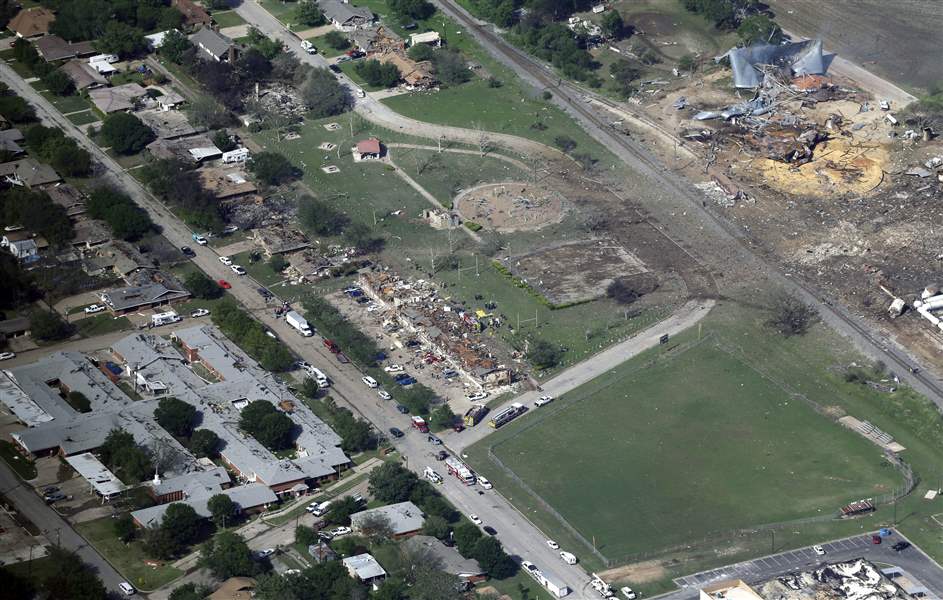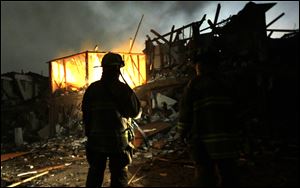
Labor Dept. cites Texas fertilizer plant for safety lapses; proposes $118,300 fine after blast
10/10/2013
FILE - This April 18, 2013, file aerial photo shows the remains of a nursing home, left, apartment complex, center, and the West Fertilizer Co. plant, right, destroyed by an explosion in West, Texas. The Texas company that operated the fertilizer plant where a thunderous explosion in April killed 15 people is facing $118,300 in fines for two dozen serious safety violations, including a failure to have an emergency response plan, federal officials said Thursday, Oct. 10, 2013. (AP Photo/Tony Gutierrez, File)
ASSOCIATED PRESS

The Texas company that operated the fertilizer plant where a thunderous explosion in April killed 15 people is facing $118,300 in fines for two dozen serious safety violations, including a failure to have an emergency response plan, federal officials said today.
WASHINGTON — The Texas company that operated a fertilizer plant where a thunderous explosion in April killed 15 people is facing $118,300 in federal fines for two dozen serious safety violations, including a failure to have an emergency response plan, officials said today.
The Occupational Safety and Health Administration, which had not inspected the facility since 1982, said West Fertilizer Co. committed violations that included unsafe handling and storage of two fertilizers, anhydrous ammonia and ammonium nitrate, a volatile chemical that investigators believe contributed to the massive blast that leveled swaths of the rural town of West, Texas, and registered as a small earthquake.
Dan Keeney, a spokesman for the West Fertilizer Co., said the company’s lawyers were reviewing the citations and proposed fine. The company has 15 days to pay the fine or file an administrative appeal with OSHA. The proposed penalties could be reduced.
“Based on what they see so far, it doesn’t appear that the violations that are alleged have anything to do with the accident, but they’re still reviewing it,” he said.
The agency issued the citations Wednesday, but due to the government shutdown, they were not disclosed until today, when Sen. Barbara Boxer, D-Calif., announced them in a conference call with reporters. The agency also cited the company for inadequately labeling storage tanks, failing to pressure-test replacement hoses and not having respiratory protection or appropriate fire extinguishers.
But West Mayor Tommy Muska said the investigation came too late.
“The damage has already been done,” he said. “It’s like shutting the door after the cow is already out.”
Investigators have been unable to pinpoint the cause of the explosion but narrowed the possibilities to three: a problem with one of the plant’s electrical systems, a battery-powered golf cart or a criminal act. They ruled out others, including a rail car on site loaded with fertilizer or someone smoking. A state criminal investigation remains open.
Today, a former paramedic who was among the most vocal first responders to the blast pleaded guilty to federal charges that he collected materials for a pipe bomb. Bryce Ashley Reed, 31, pleaded guilty to one count of conspiracy to make a destructive device and another count of attempting to obstruct justice, according to court documents. He was never linked by authorities to any criminal responsibility for the plant blast.
The April blast knocked out windows and rooftops all over the tiny town. It destroyed and damaged nearby apartments, a nursing home and two schools. Victims included 10 first responders and two others who volunteered. Debris scattered as far as two miles.
As far OSHA’s report, Suzy Price, a West resident who saved her now 92-year-old mother from a nursing home across the street from the facility the night of the blast, brushed it off, saying, “That’s government for you. Politics and government. We don’t have a chance against any of it.”
Price’s mother, who was 91 at the time of the explosion, had to be moved to a new nursing home after the original was destroyed. Her home, two blocks from the plant, was also destroyed, along with family memorabilia. Price’s home was damaged, and she’s been fighting with insurance companies for months, so OSHA’s report is little consolation, she said.
“It’s total neglect,” Price said. “It’s unbelievable”
Boxer said that despite the government shutdown, she wanted news of the citations to get out to prevent similar incidents.
“All of these things that they are cited for are pretty much standard operating procedure with how you deal with these chemicals,” Boxer said.
Muska, the mayor, also said OSHA now needs to focus on prevention. Had the facility been inspected every five years, for example, some of the problems might have been discovered ahead of time, and the explosion and deaths may have been prevented, he said, pointing out that many rural communities have similar plants either near or in downtown.
In May, The Associated Press drew on public records in 28 states and found more than 120 similar facilities within a potentially devastating blast zone of schoolchildren, the elderly and the sick. More than a half dozen states, including Ohio, Connecticut, Hawaii, Idaho and South Carolina, refused to provide information to the AP about dangerous facilities, citing the risk of terrorist attacks and their interpretations of federal law.
“We can be Monday morning quarterbacks all year long, but what we really need to do is try to prevent this,” Muska said.
The blast prompted President Barack Obama to issue an executive order on Aug. 1 giving federal agencies 90 days to draft tighter standards for the storage and handling of ammonium nitrate.